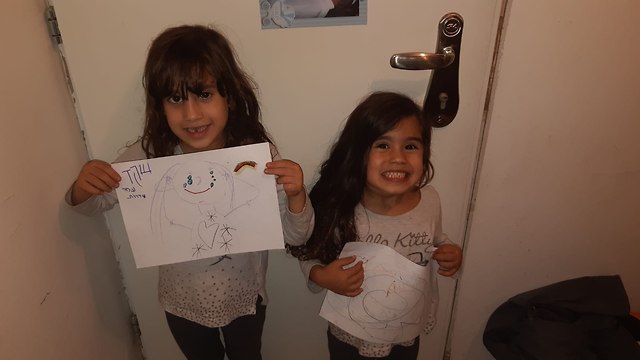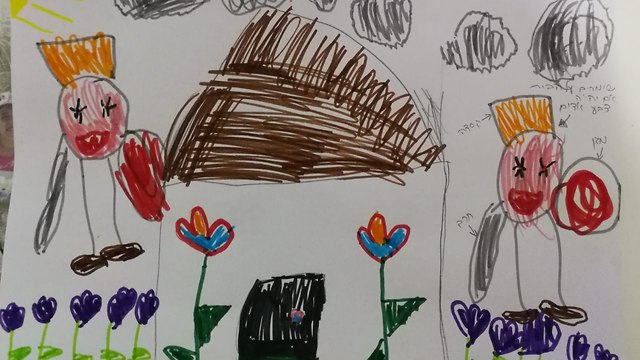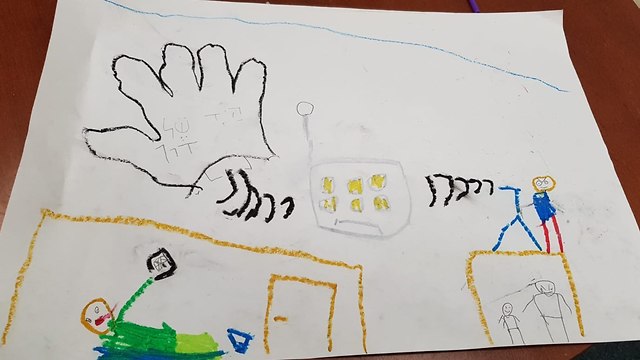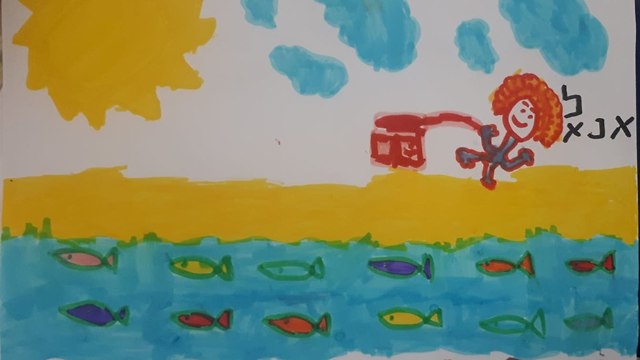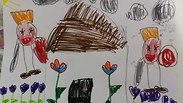
Children living near Gaza border express fear through drawing
The latest round of fighting in Gaza left many Israeli kids stuck in safe rooms and shelters for days; one of the ways in which they keep themselves busy is drawing; Michal Weiman, professional interpreter of children's drawings, found signs of severe anxiety and longing for a different reality.
We asked Michal Weimar, a decoder of children's drawings, to analyze the pictures drawn by kids for whom war has become part and parcel of everyday life. What she found is that underneath the bright colors, there is anxiety, uncertainty and a desire to create a different reality.
'Guards who protect the house from Code Red'
Six-year-old Shani Kadosh from Moshav Pri Gan painted a guard wearing a helmet and holding a shield and a sword. Shani’s mother, Mickey, explained that the guard is supposed to “protect the house when a Red Code alert is sounded."
Shani has two sisters—a two year old and a nine year old. “Last week, there were a lot of rocket alert sirens and the children were scared,” the mother said. “They asked to have their breakfast in our safe room and were afraid to come out. I put on songs for them, we danced, we tried to keep the kids busy.”
After examining the drawing, Michal emphasizing that children have “a language that is different from the language of adults. We see a picture that contains a sun, blue skies, and flowers—but if we look at how the picture is drawn, we see something completely different. The color is applied in a neurotic manner and mostly on the roof of the house in the picture, which represents thoughts.”
“We see a double door that focuses on the lock. Two flowers on each side of the door symbolize protection, and two guards, one on each side, is an attempt to reach symmetry. If we look at the way it’s drawn, we understand what the child really feels, and we can see the lack of balance, the pressure and disquiet that is felt through the picture. She’s attempting to create a different reality—with two guards that protect her in times of war,” explained the decoder.
'A hand that stops the war'
Ziv, a first grader from the Eshkol Regional Council, drew himself sleeping in a safe room. "It's actually our hallway, there’s no safe room in our house,” said Ziv’s mother.
“The sound from the rocket alert warning beeper at our house terrifies Ziv,” his mother continued, “he drew the beeper, himself and his father standing in a safe space, as well as a siren speaker near the public bomb shelter.”
Michal’s interpretation suggests Ziv’s drawing is a visual manifestation of sounds that cause his distress. "The child paints the sound waves, the noise a rocket alert makes. This is a child with auditory sensitivity, who is affected by the stressful sounds, and he expresses his distress through the drawings,” she explained.
“He drew himself with giant hands. This is what’s great about children—they can imagine themselves as Superman, someone who can stop a war, even though in reality they have no influence. This is something we should encourage children to draw, it tells them, 'You can invent any reality you want … you can change reality on the page.' It is wonderful that a child uses this as a tool to create an alternative reality—the hand that stops the war that shields him and his father," Michal elaborated.
'Men cannot defeat rockets'
The first thing we notice when we look at a drawing by seven-year-old Noya from Sderot is a giant missile that takes up almost the entire page.
Efrat Shraizin, Noya's mother, described the situation at their house whenever there is another escalation in Gaza. "My husband works in security and gets called up for duty in the middle of the night, so we have no choice but to share all the information with our two girls—Noya and her little sister, three-year-old Amelie," explained Efrat, adding, “Today the girls can differentiate between the bombs dropped by the IDF in Gaza and the rockets directed at us."
The mother went on to confess that their younger daughter wets the bed out of fear during rocket attacks, while the older one resorts to stress eating in times of security tensions.
“Despite the difficult situation we’re in, it's hard for me to hear my daughters say, 'Death to the Arabs.' I keep trying to explain to them that on the other side there are also people who suffer, and there are good people as well, not everyone is bad,” she said.
Michal says Noya’s choice to draw a disproportionately large missile—when compared to the people in her drawing, who look small— indicates that in the eyes of the child, rockets from Gaza are something that “can swallow everything in a second.”
This is also a result of the children's lack of understanding of the security situation, since kids don’t listen to “political analysts or military assessments,” all they hear are unexplained explosions and rocket alert sirens. Noya's decision not to draw land—which represents stability and security—emphasizes her uncertainty regarding the circumstances she is in.
The decoder added that hands “symbolize a person's abilities,” and Noya’s choice to draw people with small hands underlines her belief that “a man cannot defeat a rocket.”
In addition, Michal believes Noya’s choice to only use one color is reflective of her mood and not wanting “to invest in the drawing.”
'Fear and anxiety due to lack of control'
The drawing of five-year-old Anael, who is also from Sderot, is very colorful, beautiful and meticulous—showing fish swimming in the sea. However, beneath the surface lies a fear of losing control of what is going on.
"My approach is that children need to be told the truth about what's happening around them, so they understand the reality through my explanation and not through their imagination," said Adi Abergil, the mother Anael and six-year-old Noam.
"Sometimes the entire house shakes because of the explosions in Gaza, so I explain to them that there is nothing to fear, these are IDF attacks, which is why there are no rocket alert sirens,” stressed the mother.
Adi also explained that in times of security tensions, the children alter their behavior because they are in constant fear.
“Noam would go with me everywhere, even at night, he would not stop crying and hardly sleeps. Adele, the eldest of the three, woke me up one night and asked me to walk her to the toilet, and when I flushed it, she put her hands over her ears because she was afraid of the noise the water made, which had never happened before. I used to have to ask the kids to enter the safe room whenever we would hear a rocket alert siren, but now, not only do they run in there by themselves, they refuse to come out for a long time afterwards,” the mother described.
Michal says children like Anael shouldn’t be left in the dark in tense situations due to their need to remain in control and feel secure. "In Anael’s drawing, all of the items are very dense and all the elements are carefully painted,” noticed Michal. “In times of war, there is no certainty and no control over what’s happening, and children like Anael—who crave control—are the first to fall victims to anxiety and fears about the uncertainty surrounding them.”
“Children like Anael feel the importance of being given as much information as possible, so they understand the situation and are able to control it,” the decoder said.
'Kids waiting for explosions to calm them down'
Ortal, mother of six-year-old Shaked, also from Sderot, said that during the latest round of escalation, her daughter became "very anxious," and on several occasions—when there wasn’t enough time for her to get to the safe room during a Code Red alert—the six year old simply “froze.”
“It had never happened to her before … so we decided to sit her down and explain everything about the situation, so she would understand someone was protecting her … we had no choice but to give her all the information," the mother said.
“We also have 11-month-old Omri, and four-year-old Gaya—who is indifferent to the situation because she doesn’t understand it. The two girls already know within a few seconds of hearing a rocket alert siren, an explosion follows, so they wait for the explosion to calm them down,” Ortal went on to say.
Michal emphasizes that like Noya's drawing, the hands of the characters drawn by Shaked are “noticeably small, and the people in her picture have no legs—two aspects that point to feelings of helplessness and uncertainty in times of war.”
Fear is legitimate
Dalia Cohen, the director of the early childhood and family education program at the Israel Association of Community Centers, shared advice on how to ease children's fears in times of war.
Parents should give legitimacy to their children’s anxieties and fears, tell them that it’s okay to be afrai because even adults are scared sometimes. At the same time, parents should emphasize how strong their children are despite the difficult situation they’re in.
If a child reacts to the situation in an extreme manner, for instance by wetting the bed out of fear, parents shouldn't resort to reprimanding him or her but rather accept their children as they are.
The most important thing to remember in situations like these is that a child needs to feel protected. This responsibility could be split between the parents, and older siblings should be encouraged to support the younger ones.










